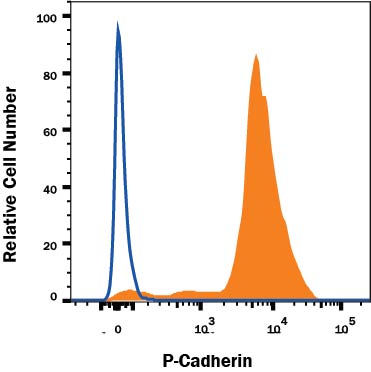Human/Mouse P-Cadherin APC-conjugated Antibody Summary
Glu100-Gly647
Accession # P10287
Applications
Please Note: Optimal dilutions should be determined by each laboratory for each application. General Protocols are available in the Technical Information section on our website.
Scientific Data
 View Larger
View Larger
Detection of P‑Cadherin in A431 Human Cell Line by Flow Cytometry. A431 human epithelial carcinoma cell line was stained with Rat Anti-Human/Mouse P-Cadherin APC-conjugated Monoclonal Antibody (Catalog # FAB761A, filled histogram) or isotype control antibody (Catalog # IC006A, open histogram). Cells were stained in a buffer containing Ca2+and Mg2+. View our protocol for Staining Membrane-associated Proteins.
Reconstitution Calculator
Preparation and Storage
- 12 months from date of receipt, 2 to 8 °C as supplied.
Background: P-Cadherin
Placental Cadherin (P-Cadherin or PCAD) is a member of the cadherin family of cell adhesion molecules, designated CDH3. Cadherins are calcium-dependent transmembrane proteins, which bind to one another in a homophilic manner. On their cytoplasmic side, they associate with the three catenins, alpha, beta, and gamma (Plakoglobin). This association links the cadherin protein to the cytoskeleton. Without association with the catenins, the cadherins are non-adhesive. Cadherins play a role in development, specifically in tissue formation. They may also help to maintain tissue architecture in the adult. P-Cadherin is a classical cadherin molecule. Classical cadherins consist of a large extracellular domain which contains DXD and DXNDN repeats responsible for mediating calcium-dependent adhesion, a single-pass transmembrane domain, and a short carboxy-terminal cytoplasmic domain responsible for interacting with the catenins. Constitutive P-Cadherin expression is found in the epidermis, mesothelium, corneal epithelium, and uterine decidua. Mouse P-Cadherin is an 822 amino acid (aa) protein with a 27 aa signal sequence and a 795 aa propeptide. The mature protein begins at aa 100 and has a 542 aa extracellular region, a 27 aa transmembrane region, and a 153 aa cytoplasmic region.
- Bussemakers, M.J.G. et al. (1993) Mol. Biol. Reports 17:123.
- Overduin, M. et al. (1995) Science 267:386.
- Takeichi, M. (1991) Science 251:1451.
- Nose, A. et al. (1987) EMBO J. 6:3655.
Product Datasheets
Citations for Human/Mouse P-Cadherin APC-conjugated Antibody
R&D Systems personnel manually curate a database that contains references using R&D Systems products. The data collected includes not only links to publications in PubMed, but also provides information about sample types, species, and experimental conditions.
2
Citations: Showing 1 - 2
Filter your results:
Filter by:
-
Comparison of Human Antral Follicles of Xenograft versus Ovarian Origin Reveals Disparate Molecular Signatures
Authors: L Man, N Lustgarten, E Kallinos, Z Redhead-La, S Liu, B Schattman, D Redmond, K Hancock, N Zaninovic, G Schattman, Z Rosenwaks, D James
Cell Rep, 2020-08-11;32(6):108027.
Species: Human
Sample Types: Whole Cells, Whole Tissue
Applications: Flow Cytometry, ICC, IHC -
Macrophages contribute to the cyclic activation of adult hair follicle stem cells.
Authors: Castellana D, Paus R, Perez-Moreno M
PLoS Biol, 2014-12-23;12(12):e1002002.
Species: Mouse
Sample Types: Tissue Homogenates
Applications: Flow Cytometry
FAQs
No product specific FAQs exist for this product, however you may
View all Antibody FAQsReviews for Human/Mouse P-Cadherin APC-conjugated Antibody
There are currently no reviews for this product. Be the first to review Human/Mouse P-Cadherin APC-conjugated Antibody and earn rewards!
Have you used Human/Mouse P-Cadherin APC-conjugated Antibody?
Submit a review and receive an Amazon gift card.
$25/€18/£15/$25CAN/¥75 Yuan/¥2500 Yen for a review with an image
$10/€7/£6/$10 CAD/¥70 Yuan/¥1110 Yen for a review without an image

